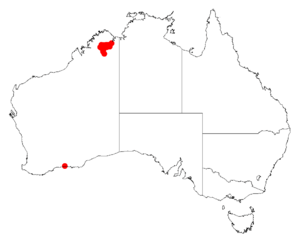Acacia chrysochaeta facts for kids
Quick facts for kids Acacia chrysochaeta |
|
|---|---|
| Scientific classification | |
| Genus: |
Acacia
|
| Species: |
chrysochaeta
|
 |
|
| Occurrence data from AVH | |
Acacia chrysochaeta is a type of shrub, a small woody plant, that belongs to the Acacia family. It's special because it only grows naturally in a small part of northwestern Australia.
What Does Acacia Chrysochaeta Look Like?
This shrub is usually thin and stands upright. It typically grows to about 1.3 meters (around 4 feet) tall.
Its small branches are round (like a pencil), have tiny veins, and are covered in thick hair. They are mostly brown, but the tips can look yellowish. Like many Acacia plants, it doesn't have regular leaves. Instead, it has special flattened stems called phyllodes that look and act like leaves.
These phyllodes are flat, long, and stay green all year. They press closely against the stems. Each phyllode is about 2 to 4.5 centimeters long and 1 to 3 millimeters wide. They have tiny, soft hairs and one main vein that stands out, along with many smaller veins running next to it.
The plant blooms with yellow flowers, usually in May and June, or sometimes in October and November. Its flower-spikes are shaped like cylinders, about 2.5 to 3 centimeters long, and are packed with bright golden flowers.
After the flowers, narrow, oblong seed pods grow. These pods are mostly straight or slightly curved, about 4.5 to 6 centimeters long. They are covered in tangled, golden, woolly hairs that turn white as they get older. Inside, the black seeds are arranged diagonally. Each seed is oblong and measures about 4 to 4.5 millimeters long.
Where Does This Plant Grow?
Acacia chrysochaeta is found only in the Kimberley region of Western Australia. It grows in sandy soil, especially near rivers and streams in remote areas. You can find it from around the Gibb River to near Karungie Station. It is part of open plant communities where Eucalyptus trees are common.

